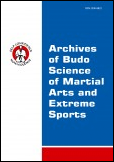2018, Volume 14, Issue 1
Optimization of physical training of the qualified muay thai athletes of light weight categories
Ilia Afanasievich Cherkashin1, Elena Viktorovna Krivoruchenko2, Władysław Jagiełło3, Sergii Sidorovich Iermakov4, Leonid Vladimirovich Podrigalo5
1Institute of Physical Culture and Sports, North-Eastern Federal University in Yakutsk | Yakut State Agricultural Academy, Yakutsk, Russia
2Institute of Physical Culture and Sports, North-Eastern Federal University in Yakutsk, Yakutsk, Russia
3Department of Physical Education, Gdansk University of Physical Education and Sport, Gdansk, Poland
4Department of Tourism and Recreation, Gdansk University of Physical Education and Sport, Gdansk, Poland
5Kharkov State Academy of Physical Culture | V.N. Karazin Kharkiv National University, Kharkov, Ukraine
Author for correspondence: Władysław Jagiełło; Department of Physical Education, Gdansk University of Physical Education and Sport, Gdansk, Poland; email: wjagiello1@wp.pl
Full text
Abstract
Background & Study Aim: The muay thai (martial art originally from Thailand) characterized by the combined use of fists, elbows, knees, shins and feet. The purpose of the research is to increase in efficiency of qualified athletes’ physical training of muay thai light weight categories on the basis of the developed technique.
Material & Methods: Forty muay thai athletes (the I sports category) of light weight categories participated in a research (12 category up to 51 kg; 14 category up to 54 kg; 14 category up to 57 kg). Experimental group (n = 20) age 21 ±1.58 year; control group (n = 20) age 21 ±1.43 year.
Results: It is developed the assessment scales of athletes’ general and special physical fitness which take into consider sports qualification and weight categories of athletes. It is developed the physical training technique of muay thai athletes of light weight categories (based on the integrated assessment of athletes’ physical fitness by means of the battery of tests). The athletes of the experimental group have shown significant improvement of indicators in all tests of the general and special working capacity. It was determined the significant improvement in tests of the control group: reproduction 50% of force of the right and left hand with the visual analyzer; standing long jump; two-sided combinations of strikes by elbows. It is defined the positive change of the general level and integrated assessment of athletes’ fitness of the experimental group (the basis is harmonious development of physical fitness indicators). The high success of athletes of this group is confirmed by results at prestigious competitions.
Conclusions: The technique of integrated assessment of physical fitness includes the complex of pedagogical tests; the differentiated rating scales; the algorithm of test conducting and identification of athletes’ fitness level. It is performed the gradation of athletes’ physical fitness by absolute and relative assessments. It allows to correct the training process directed to increase in the level of athletes’ physical fitness.
Key words: control, evaluation criteria, physical fitness, technique, training process





